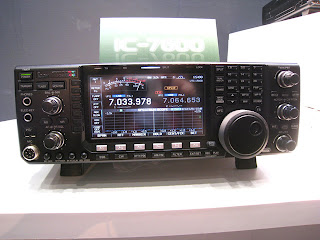DX Bulletins Willis Island DxpeditionA team of mainly German radio amateurs have been
operating from Willis Island, in the Coral Sea,
north-east of Australia, since earlier this month,
using the call sign is VK9DWX.
The group's signals have been heard on most HF bands in
EI and GI, with 31 EI call signs and 25 GI call signs
in the log by Thursday 23rd October, for a total of 124
QSOs. 20 metres and 17 metres have been the best bands
to work Willis Island from Ireland, however the group's
logs show QSOs with Irish stations on all HF bands
except 10 metres. Monday the 27th October, is
expected to be the final day for the DXpedition.
-----------------------------------------------------------
Radio Rallies1-2 November: North Wales Radio Society 22nd North
Wales Amateur Radio Show Llandudno Radio Rally The new
site is the brand new John Bright high school in
Llandudno.
2nd November: Foyle & District Amateur Radio Club
Annual Rally in The White Horse Hotel Campsie,
Londonderry Doors open at 11:30 a.m. for Disabled
access Main event at 12-noon info
www.mn0aku.orgSunday 23rd November: Mayo Radio Rally, Belmont Hotel,
Knock, Co. Mayo. Doors open at 11:30 a.m. Rally
Director, Padraic Baynes, EI9JA info
www.ei7mre.org-------------------------------------------------
IOTA Contest ResultsProvisional results for this year's Islands On The Air
Contest have been published. Scores for the EI and EJ
entries are available on the IRTS web site, which also
includes a link to the full provisional results.
The top scoring EI/EJ station was EJ0GI, a combined
team from South Dublin Radio Club and City of Belfast
Amateur Radio Society, who operated from Inis Oirr.
This group achieved 6th place worldwide in their
category. The other EI/EJ stations with scores in the
million-plus range were EI0W (Dundalk Amateur Radio
Society) and EI9HX (Pat O'Connor). Other EI/EJ stations
also achieved high category placings, as can be seen
from the contest results page on the IRTS web site.
Another joint EI/GI entry was GI0MPG, operating from
Rathlin Island, who achieved 13th place worldwide in
their category. This year's IOTA contest attracted more
than 1800 entries worldwide, making it one of the most
popular contest of the year.
-------------------------------------------------------
Global Simulated Emergency Test November 2008The next IARU EmComm Party on the Air is scheduled
for Saturday the 8th of November between 0400 and
0800 hours UTC. The time of each exercise changes to
allow more stations to participate from around the
world as well as recognising that emergencies can
happen at any time
This is an exercise between stations interested in
emergency communications and is not a contest. Activity
will be concentrated around the IARU Emergency Centre
of Activity frequencies which are 3760, 7060, 14300
and 21360 kHz.
----------------------------------------------------------
Great news for 5 MHzGood news at last. After a long process of contacts
between the military authorities and ComReg the first
of the 5 MHz licences issued on Friday week last
October 17th. We hope by now that all of those who
applied have received the necessary permission. The
permission varies the terms and conditions of the
licences concerned so as to include three 3 kHz
channels with centre frequencies of 5280, 5400 and 5405
kHz. The practice is to use Upper Sideband for voice
transmissions on these channels. As these are centre
channel frequencies and the actual dial readout on
upper sideband is 5278.5, 5398.5 and 5403,5 kHz
respectively i.e. 1.5 kHz on the low frequency side of
the centre of the channel. The maximum power allowed is
200 watts. CW stations are encouraged to use the bottom
300 Hz of the channels as this permits the use of the
channel for SSB at the same time.
It should be noted that military cadet stations in the
UK which use special non amateur call signs are allowed
to participate in the 5 MHz experiment in the UK. EI
stations with 5 MHz permissions can not communicate
with these stations and may only communicate with other
licensed experimenter or amateur stations.
Dave EI3IO was one of the first EI’s on the band and
has sent us some observations. He indicates that 5 MHz
with its near optimum Near Vertical Incidence Skywave
(NVIS) properties provides superb and stable
communication during daylight hours around the Western
European Isles of EI, G, GI, GW and GM. At night,
stations in North America on the East Coast and the Mid
West were easily workable.
After 48 hours with the 5 MHz permission Dave worked
12 DXCC countries including Bermuda, Greenland and
Puerto Rico. In all he had 82 QSO’s in that period
with the best DX being K5RK in Alvin Texas at 7189
kilometres. Other EI’s heard on the band were EI7CD,
EI6IZ and EI7CC.
Finally a word of thanks to ComReg and to the primary
spectrum user for facilitating the release of the three
channels at 5 MHz for experimentation
-------------------------------------------------------
Morse Code tests at Mayo RallyThere will be Morse Code tests available at the
upcoming Mayo Rally on the 23rd of November. These
tests must be booked in advance by contacting Sean
Donelan EI4GK telephone 01 2821420.
-------------------------------------------------------
Learn Morse Code Online - K8ASA
WOW! The whole purpose of this website is to encourage new no-code hams,
and others, to try the C.W. mode. No one can know how great it is until they
experience it for themselves. There has always been a problem of learning
Morse code in the first place. Well rest assured I came across this interesting Blog. A Blog devoted to preserving the unique, and vital, CW amateur radio environment,
Morse Code, as well as the great hobby of Amateur Radio in all its apparitions.
Enjoy, 73's












